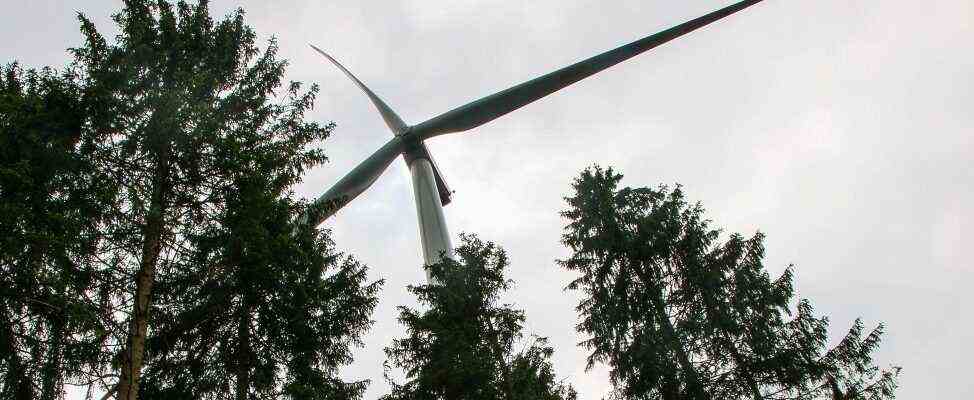The relaxation of the 10-H rule for wind turbines announced by the Bavarian state government is intended to give the regenerative energy form that has recently stalled in the Free State a tailwind. Manuel Pretzl, parliamentary group leader of the Munich CSU, now apparently sees the time to push wind power politically and calls on the state capital to look out for other locations in and around Munich.
He is also explicitly thinking of the urban forests in the district of Munich, which are managed by the Munich forest companies. Pretzl is planning to build ten more wind turbines, and the Stadtwerke München will review possible locations. An aerial number by the CSU man, or a new approach with a perspective?
The CSU district councilor and member of the state parliament Ernst Weidenbusch does not share the confidence of his Munich party friend. “The wind conditions in the district are not such that this is a sensible idea,” says Weidenbusch. If the wind actually gets stronger, one can always react.
Stadtwerke München is skeptical for the same reason. The topography in the foothills of the Alps with its many hills is nowhere near as favorable as in northern Germany, for example, where the wind can develop its full force on a flat surface, says Michael Silva, deputy press spokesman for Münchner Stadtwerke.
On the other hand, Christoph Nadler, leader of the Greens in the district council, reacts in a cautiously positive manner to Manuel Pretzl’s advance. It goes without saying that he is fundamentally in favor of the expansion of wind energy, which should always take the form of public facilities. But it was also the CSU-led state government that slowed down the development of this alternative form of energy with the adoption of the 10-H regulation.
Wind turbines at the East Exhibition Center or along the A99?
But now Prime Minister Markus Söder (CSU) has announced a reform of this 10-H rule. So far, this stipulates that wind turbines have to be ten times as far away from residential developments as they are high, which means that areas that meet these requirements can be counted on one hand. In the state forest, in pre-polluted areas as well as on military training areas, according to Söder’s considerations, only a minimum distance of one kilometer should therefore be maintained in the future.
In the opinion of the Munich CSU parliamentary group leader Pretzl, new wind turbines could therefore be erected at the East Exhibition Center or along the A 99 – and in the urban forests, also beyond the city limits.
A lot of wood comes together: The state capital cultivates around 5000 hectares of forest, 1200 hectares of which are managed by the municipal forest administration in the district of Munich, about 131 hectares in the east and west of the city, including Neuried and Feldkirchen, and 35 hectares in the south, including forests along the Isar near Grünwald. Not owned by the city, but also under the responsibility of the municipal forest administration, there are 337 hectares of Stadtwerke München, including areas near Garching, and 746 hectares of the Heiliggeiststiftung in Forst Kasten.
“At Marienplatz it is difficult to set up a wind turbine”
For Sebastian Schall, the environmental policy spokesman for the CSU city council group, it is obvious that the state capital, as one of the largest forest owners in Bavaria, should look for suitable locations for wind turbines in the surrounding area. “It’s difficult to put a wind turbine on Marienplatz,” he says.
The environmental policy spokesman for the Munich CSU city council group, Sebastian Schall
(Photo: Robert Haas)
Stadtwerke spokesman Silva, who speaks of luck that two suitable places could be found in the city: On the Fröttmaninger Berg in Munich there has been a wind turbine since 1999, in January 2021 it is on the north-west landfill in Freimann a second, much more modern one went into operation. Together, they generate 8.9 million kilowatt hours of green electricity annually, which can be used to supply 3,600 households. The municipal utilities are still very interested in promoting the expansion of green electricity generation in the region, where it makes ecological and economic sense, but they did not want to build a “symbolic wind turbine”, as the first of its kind was called in Fröttmaning at the time .
While there is a big question mark behind urban wind turbines on the district floor, the planning of the district communities for the construction of rotors in Hofoldinger Forst and In Forstenrieder Park is progressing. Even after Brunnthal’s exit from the Arge Hofoldinger Forst, the municipalities of Sauerlach, Otterfing and Aying continue to pursue the joint wind power project with at least three wind turbines undeterred and the project planned by the municipalities of Pullach and Neuried in the Forstenrieder Park with three to five wind turbines is “at full speed der Mache “, as Pullach’s Second Mayor Andreas Most (Pullach Plus) reports.
The plans would get a tailwind from the accession of the municipality of Baierbrunn, which has not yet been decided. A spokesman for the Baierbrunn town hall said that a possible entry into the working group was discussed at the latest municipal council meeting. A resolution was passed to confirm the interest in participating in the consortium. However, there will be further discussions on this, a final decision has not been made.

